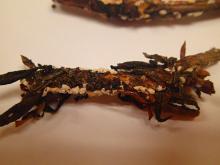Acanthococcus (Eriococcus) azaleae
Pest description and damage Scale insects are small (less than 0.13 inch in length) soft insects that live beneath waxy deposits. These insects are often identified by the shape and size of their scales, the description of adult males and females, immature crawler stage, color of eggs, and host plant preferences. The immature azalea bark scale superficially resembles a mealybug in appearance. Mature female scales are about 0.13 inch in length and appear like white cottony sacs, often located on twigs and stems of azalea, especially in branch axils. Eggs, crawlers, and adults under the whitish scales are red. Hosts include andromeda, azalea, rhododendron, hawthorn, poplar, willow, and most recently, blueberry in the Pacific Northwest.
Biology and life history The azalea bark scale overwinters as an adult and lays eggs in the spring. The young scales (called "crawlers") are the mobile form of this insect; they migrate through the foliage to feed. As they feed and mature, they form a protective shell over their bodies. There is usually one, or possibly two, generations per year.
Pest monitoring Inspect twigs and tissues during the dormant season for scale insects. Pay attention to sickly plants and those with low vigor. The newly emerged crawler is the stage most susceptible to chemical control. Monitor for crawlers by wrapping a piece of sticky tape around an infested branch with the sticky side out. The red crawlers are very small and best observed with a 10X magnifying glass.
Management-biological control
Several species of beetles and parasitic wasps help control scale populations. Check beneath the waxy scales to determine if there is a live infestation. Avoid use of broad-spectrum insecticides, which can kill these predators.
Management-cultural control
Scrape scales off plants by hand with fingernail or toothbrush. Prune off major infestations. Apply doublesided sticky tape near infestations of adult scales to catch the crawler stage. As with aphids, avoid excessive nitrogen fertilizer, as this favors population increase.
Management-chemical control
See Table 1 in:
Chemical Control of Landscape Pests
For more information
See "Scale insect" in:
Rosetta, R. 2006. Azalea bark scale (https://agsci.oregonstate.edu/nurspest/insects/azalea-bark-scale)


